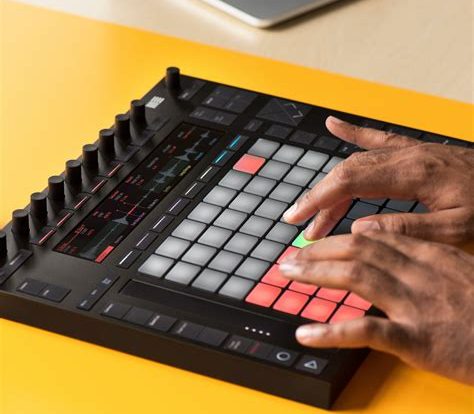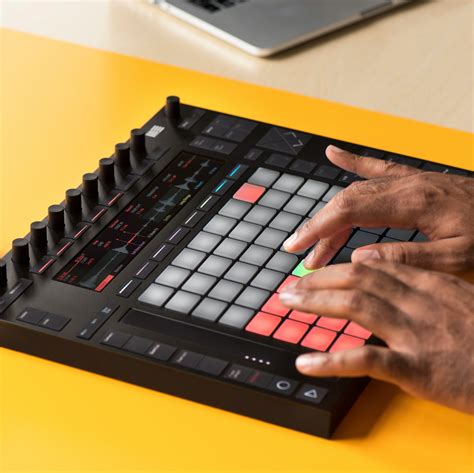

Learn how to make beats like a pro with our easy-to-follow tutorials and top-of-the-line software. Start creating your own music today!
Are you tired of scouring the internet for the perfect beat to accompany your lyrics? Look no further than making your own beats. Not only will it save you time and money, but it also allows for complete creative control over the sound of your music. And the best part? You don’t need any prior experience in music production to start.
Firstly, start with finding the right software or hardware to suit your needs. There are plenty of free options available online, such as GarageBand or LMMS, or you can invest in more advanced programs like Ableton or FL Studio. Once you have your tools ready, it’s time to get creative and experiment with different sounds and rhythms.
Don’t be afraid to mix genres or try unconventional techniques – the beauty of making your own beats is that there are no rules. Whether you want to make a trap beat with heavy bass or a chill lo-fi hip hop track, the possibilities are endless.
So why wait? Start making your own beats today and take your music to the next level.
Daftar Isi
Introduction
Aspiring music producers and beatmakers can sometimes feel overwhelmed with the idea of creating their own beats. But with the right tools and mindset, anyone can make beats from scratch without any formal training. In this article, we’ll explore some tips and tricks to help you get started on your journey towards making beats that sound professional and unique.
Find Inspiration
Before you start creating your own beats, it’s important to find inspiration from other producers and musicians. Listen to a variety of music genres and analyze the beats. Take note of what elements you like and what you don’t. This will give you a better understanding of what kind of beats you want to create.
Experiment with different sounds
Once you have an idea of what kind of beats you want to make, it’s time to experiment with different sounds. You can use virtual instruments and drum samples to create your own unique sounds. Don’t be afraid to try out new things and take risks. This is how you’ll find your own sound.
Get a DAW (Digital Audio Workstation)
A DAW is a software program that is used for recording, editing, and producing music. There are many different DAWs available, both free and paid. Some popular choices include FL Studio, Ableton Live, and Logic Pro X. Choose a DAW that fits your budget and workflow.
Learn the basics of your DAW
Once you’ve chosen your DAW, it’s important to learn the basics. Watch tutorials and read articles to understand the different features and functions of your DAW. This will help you work more efficiently and effectively.
Create a Melody
The melody is the most important part of any beat. It’s the part that people will remember and sing along to. To create a melody, start with a simple chord progression and build from there. Experiment with different notes and rhythms until you find something that sounds good.
Add drums and percussion
Once you have a melody, it’s time to add drums and percussion. Choose drum samples that complement your melody and create a rhythm that fits the mood of the beat. Don’t overdo it with too many drums – sometimes less is more.
Add bass and other instruments
Now that you have a melody and drums, it’s time to add some bass and other instruments. The bassline should complement the melody and add depth to the beat. Other instruments can be added to fill out the sound and create a more complex arrangement.
Mix and Master
Once you have all the elements of your beat, it’s time to mix and master. Mixing involves balancing the levels of each instrument and making sure they all sound good together. Mastering involves adding effects and making sure the final mix sounds polished and professional.
Conclusion
Creating your own beats can be a fun and rewarding experience. With the right tools and mindset, anyone can make beats that sound professional and unique. Remember to find inspiration, experiment with different sounds, learn your DAW, create a melody, add drums and percussion, add bass and other instruments, and mix and master your final product. Good luck on your beatmaking journey!Aspiring music producers often face the challenge of producing high-quality beats without having to spend thousands of dollars on expensive equipment. With the advent of technology, it has become possible to create professional-grade beats using affordable software and hardware. Here are ten tips on how to make beats without breaking the bank:Firstly, invest in a computer and a Digital Audio Workstation (DAW). The first step in creating beats is having access to a computer and a DAW. There are many affordable DAWs such as FL Studio and Ableton that offer a wide range of features and functionalities to create professional sounding beats. Once you have your DAW, experiment with free software like Audacity and plugins like VSTs to enhance your beats’ quality while keeping your expenses down.Another way to save money and time is to use royalty-free samples. Rather than creating sounds from scratch, use samples from websites like Splice and Sounds to help expedite the beat-making process. Additionally, reusing sound samples that you have already created can save time and money creating new sounds.Utilising online tutorials is another great way to save time and money. Many music producers and beat-makers have created helpful online tutorials to help individuals navigate the beat-making process with their DAW or devices. Learning from these tutorials can help save time and money by showing you how to get the most out of your equipment.Creating a workable space is also essential. Invest in a high-quality headphone, speaker, or both to help you mix your sound and create a comfortable and conducive environment to work in. Collaborating with other individuals provides an opportunity to learn and grow with others. Additionally, sharing resources and equipment can help reduce expenses and create supportive networks.Finally, social media platforms serve as a great platform to share and promote your work. You can use various channels such as Instagram, Twitter, and Facebook to connect with other individuals, share your music and ask for feedback. Remember that creating beats takes time and effort, but it’s also a fun and creative process. So, let your passion and creativity guide you as you create fantastic beats.Making beats has become a popular pastime for music enthusiasts all over the world. With the advancement of technology, it has become easier than ever to create high-quality beats from the comfort of your own home. However, like any hobby or profession, there are pros and cons to consider before jumping into the world of beat-making.Pros:1. Creativity: Making beats allows you to express your creativity in a unique and individual way. You have the freedom to experiment with different sounds, rhythms, and melodies to create something that is truly your own.2. Accessibility: With the availability of beat-making software and equipment, making beats has become more accessible than ever. You don’t need a professional studio or expensive equipment to get started, and you can easily learn the basics online.3. Opportunity: The music industry is constantly evolving, and there is always a demand for new and innovative beats. Making beats can open doors to opportunities such as collaborations, licensing deals, and even producing for major artists.Cons:1. Skill: While making beats may seem easy, it actually requires a certain level of skill and knowledge. It takes time and practice to develop the technical skills necessary to create high-quality beats.2. Cost: Although beat-making can be done on a budget, investing in high-quality software and equipment can be expensive. It’s important to consider the cost of these tools before diving into beat-making as a hobby or profession.3. Competition: With the rise in popularity of beat-making, the industry has become increasingly competitive. Standing out amongst other producers and beat-makers can be a challenge, and it may take time to establish a name for yourself.In conclusion, making beats can be a rewarding and fulfilling hobby or profession for those with a passion for music. However, it’s important to consider the pros and cons before getting started. With hard work, dedication, and perseverance, anyone can create high-quality beats that stand out from the crowd.
If you’re an aspiring musician or a seasoned producer, you know that coming up with a title for your beat can be a daunting task. Sometimes, the beat is so good that it speaks for itself, and adding a title can feel like you’re forcing something that isn’t there. So, what do you do? Is it possible to make beats without titles?
The short answer is yes, absolutely! In fact, some of the most iconic beats in music history don’t have titles. Take, for example, the instrumental track in Dr. Dre’s The Chronic album. The beat, commonly referred to as Dre Day, doesn’t have an official title but is still recognized as one of the greatest hip-hop beats of all time.
When it comes to making beats without titles, the key is to let the music speak for itself. Don’t try to force a title just because you think it’s necessary. Instead, focus on creating a beat that captures the mood and emotion you’re trying to convey. Let the listener interpret the music in their own way and come up with their own title or meaning, if they feel inclined to do so.
In conclusion, making beats without titles is not only possible, but it can also be a liberating experience. Don’t be afraid to let the music speak for itself and let the listener come up with their own interpretation. After all, music is a form of art, and art is meant to be interpreted in a multitude of ways. So, go ahead and create that beat without a title, and who knows, it might just become the next iconic instrumental track!
Aspiring musicians and beat enthusiasts often have questions about the process of making beats. Here are some of the most common questions people ask:
- What equipment do I need to make beats?
- A computer or laptop with music production software such as Ableton Live, Logic Pro, or FL Studio.
- A MIDI controller or keyboard to input notes and rhythms.
- Audio interface for recording live instruments or vocals.
- High-quality headphones or studio monitors for accurate sound reproduction.
- Do I need to know how to play an instrument to make beats?
- No, it is not necessary to know how to play a traditional instrument to make beats. However, having a basic understanding of music theory and rhythm can be helpful in creating more complex and interesting beats.
- How do I come up with ideas for beats?
- Listen to different genres of music and pay attention to the rhythms and sounds that catch your ear. Experiment with different combinations of instruments and samples to create unique sounds.
- Can I make money from selling my beats?
- Yes, there is a growing market for producers and beatmakers to sell their beats online through platforms such as Beatstars or Airbit. However, it takes time and effort to build a following and establish a brand as a producer.
Making beats can be a fun and rewarding hobby or career path for those with a passion for music production. With the right equipment, knowledge, and creativity, anyone can learn to make beats that stand out and make an impact.






